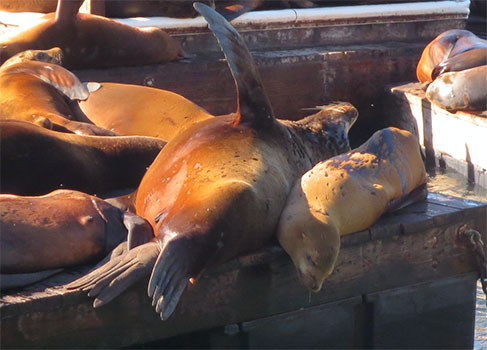It's summertime in San Francisco, which means travelers from around the world are flocking to the City by the Bay to experience clam chowder, cable cars and our dear friend Karl the Fog.

Photo courtesy of Sea Lion Center
By Mallory Johnson
Published: August, 2016
It’s summertime in San Francisco, which means travelers from around the world are flocking to the City by the Bay to experience clam chowder, cable cars and our dear friend Karl the Fog.
Despite all the extra bodies in the city this time of year, some iconic characters are noticeably absent from the landscape. San Francisco’s world-famous sea lions, who frequently inhabit the docks at PIER 39, are nowhere to be found. Rafts that were previously occupied by the masses are suddenly vacant, and the resounding barks that once filled the wharf have abruptly fallen silent.
No need to worry though, because these charismatic mammals are just taking a little summer vacation of their own.
For the majority of the year, male and female sea lions spend their time apart. Male sea lions typically hang out in Northern California, many of them taking over the docks at PIER 39. Meanwhile, female sea lions stay around the Channel Islands in Southern California or along the coast of Mexico.
During mating season, male sea lions migrate south to meet up with the ladies and begin their courtship. Males must win over a mate by establishing and defending a territory. The females will wander through the territories to pick a partner, avoiding males who are overly assertive or aggressive. At the end of breeding season—generally around late August or early September—the males will migrate back north, with many of them returning to their bachelor pad at PIER 39.
To help fill the void until our dear friends return, here are eight facts about California sea lions.
1.- Sea lions have an inherent biological need to be in close contact with one another. This innate urge, called “thigmotaxis,” helps keep the body temperature of these warm-blooded mammals up.
2.- Males are much larger than females, boasting a thicker neck and protruding crest atop their heads. Males also have a darker hide, while females and juveniles are normally light brown or gray.
3.- California sea lions are known for their intelligence, playfulness and noisy barking.
4.- Sea lions are top predators who enjoy variety in their diet, feeding on squid, octopus, herring, rockfish, salmon, anchovies and more. They are considered opportunistic feeders, which means they will eat any available prey instead of focusing on one species.
5.- California sea lions, along with other marine mammals, are protected by the Marine Mammal Protection Act. It is unlawful for unauthorized persons to feed, handle or harass them.
6.- PIER 39’s convenient location near the Bay entrance provides sea lions with easy access to feed on schooling fish like the anchovies and herrings they so relish.
7.- In addition to access to food, San Francisco Bay offers another key benefit to California sea lions—the shallow and less salty water provides protection from predators like great white sharks.
8.- While they don’t face predators in the Bay, sea lions do face other threats. Marine debris and plastic pollution cause many problems for these charismatic mammals. Sea lions are curious creatures and use their noses to investigate floating objects, causing items like plastic fishing line, nets, or other marine debris to become entangled around their necks. Other human-created issues for sea lions include ingestion of plastic trash.
Together, we can help minimize these dangerous hazards to sea lion health by using less plastic and joining local coastal cleanups to keep trash out of our Bay and ocean. You can also discover more facts about California sea lions, and how we can all do our part to keep them safe, by visiting the Sea Lion Center on PIER 39, located just above the sea lions’ hangout on K-Dock. Learn more by visiting www.sealioncenter.org.
Mallory Johnson is the Communications Manager at Aquarium of the Bay, a nonprofit dedicated to protecting, restoring and inspiring the conservation of San Francisco Bay and its watershed.

